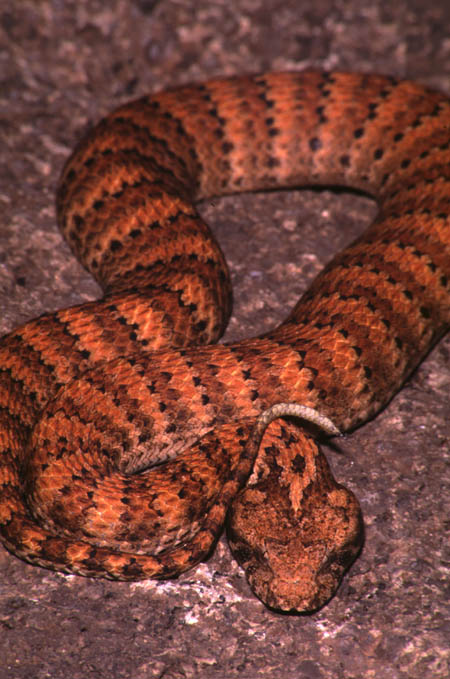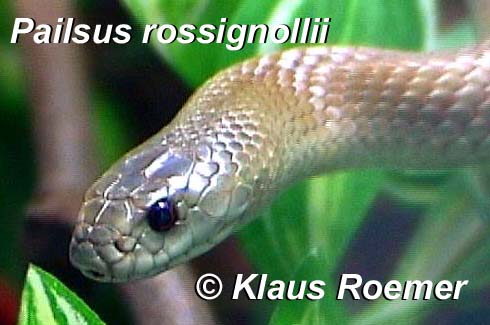|
Night Feeding on a road by a frog (Helioporus australiacus). |
Raymond Hoser
488 Park Road, Park Orchards, Victoria, 3134, Australia.
Phone: +61 3 9812 3322 Fax: 9812 3355 E-mail:
Originally published in Herpetofauna 32(2), December 2002:100-101.
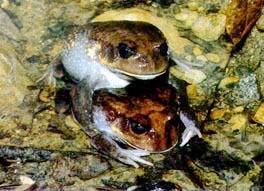 This note reports on a frog deliberately seeking out insect food on a roadway at night.
This note reports on a frog deliberately seeking out insect food on a roadway at night.
On 21 February 2002, I was spotlighting by car in the Cottage Point Road / West Head Road area of Kurringai Chase National Park to Sydney's immediate north.
Wildlife was observed only and not retained.
The following data were recorded:
Weather that day had been fine, hot and seasonally above average.
Spotlighting was from 8-11.30 PM.
At this time there was little wind, save for a very slight north-easterly that blew at times during the night.
The sky was clear with some low see-through cloud coming over from the north-east. There was a moon in the sky all night.
Air temperatures at time of drive ranged from 24-22 degrees Celsius.
The frog was first seen on the road on General San Martin Drive. It was about 100 metres from the first toll booth near McCarr's Creek Road (the booth at the top of the hill at Terry Hills Lat. 33° 40' S, Long. 151° 13' E).
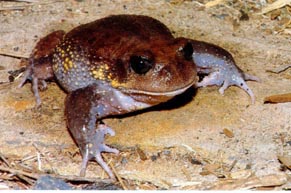 After three more passes on the same section of road I noticed that the frog was still on the road and had moved from one side of the bitumen to the other (as if crossing), but then back again to the side of the road it had been originally seen on.
After three more passes on the same section of road I noticed that the frog was still on the road and had moved from one side of the bitumen to the other (as if crossing), but then back again to the side of the road it had been originally seen on.
Whether by chance or otherwise, the frog always seemed to be in the area of the road which allowed cars to pass over it (on one or other side of the centre of the road), with the wheels on either side of the frog.
As a result of this observation, I pulled up near the frog on the fourth pass.
I then turned off the car's engine and headlights and observed the behavior of the frog, which apparently ignored my presence.
All this was possible due to the good illumination provided by the moonlight, the fact that I remained still at materially relevant times and the added help provided by the headlights of passing cars.
Over the next twenty minutes ten cars were observed to pass the frog, either over it, or on the other side of the bitumen.
Following the passing of a car directly over the frog it would move it's body around in a circular motion, as if looking for fallen insects. Generally the frog wouldn't move away, unless it took up an insect, when it would hop towards the food and lap it up. This was observed twice.
In general the traffic was leaving the park and hence the frog was situated on the same side of the road along which this traffic was.
However, on one occasion a car passed on the opposite side of the road to the frog. The frog responded by hopping across the roadway to where this car had passed and positioned himself on that side of the road in the path of more oncoming traffic.
Within a few minutes another car passed on the other side of the road (leaving the National Park) with the frog moving back to that side of the roadway.
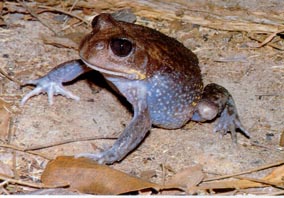 After observing the frog's behavior for 20 minutes, I continued spotlighting for about another 40 minutes, noticing that the frog continued to hunt and feed in the path of oncoming traffic (when I passed this spot). On the final pass of this piece of road at about 11.30 PM, the frog was still alive and well and sitting in the path of oncoming cars.
After observing the frog's behavior for 20 minutes, I continued spotlighting for about another 40 minutes, noticing that the frog continued to hunt and feed in the path of oncoming traffic (when I passed this spot). On the final pass of this piece of road at about 11.30 PM, the frog was still alive and well and sitting in the path of oncoming cars.
In all, well over 20 cars must have passed over the frog, but it was never hit.
DISCUSSION
Over the period 1978-2002 I have regularly driven the roads of the West Head/Cottage Point area of Kurringai Chase National Park at night in search of herpetofauna.
With more than 100 night drives over this time in all kinds of weather conditions deemed likely to yield reptiles and frogs, I feel that I have a good grasp of the habits of most reptiles and frogs in the area in terms of their likely nocturnal movements and associated habits (see Hoser, 1984a; 1984b and 1989).
The preceding instance of road feeding by an adult Helioporous australiacus at night is the first such case I have observed.
That the behavior is not common, would be assumed on the basis that specimens that do this would soon be hit and killed by passing traffic.
However, as few people who go spotlighting for frogs on roads at night actually stop to observe the behavior of the frogs seen, the behavior observed may be more than previously thought.
There is also a possibility that some frogs may seek out roads for the purpose of finding food.
REFERENCES CITED
Hoser, R. T. 1984a. Search for the Death Adder, Notes From NOAH, 11 (9):12-14.
Hoser, R. T. 1984b. Preferred activity temperatures of nocturnal reptiles in the Sydney area, Herptile 9 (1):12-13.
Hoser, R. T. 1989. Australian Reptiles and Frogs, Pierson and Co., Sydney, NSW, Australia. 238 pp.
 To download the pdf (Acrobat) file of the
exact article as a 100 kb file, as it appeared in the journal Herpetofauna - click here - it will take up to 10 minutes to download with dial-up connections.
To download the pdf (Acrobat) file of the
exact article as a 100 kb file, as it appeared in the journal Herpetofauna - click here - it will take up to 10 minutes to download with dial-up connections.